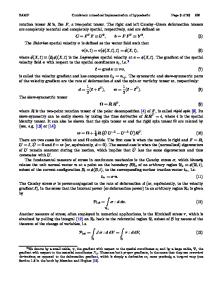Application of a thermo-elastoplastic constitutive model for numerical modeling of thermal triaxial tests on saturated c
- PDF / 3,560,863 Bytes
- 15 Pages / 595.276 x 790.866 pts Page_size
- 31 Downloads / 233 Views
TECHNICAL PAPER
Application of a thermo‑elastoplastic constitutive model for numerical modeling of thermal triaxial tests on saturated clays Mohammad Sadegh Ashrafi1 · Amir Hamidi1 Received: 17 March 2020 / Accepted: 25 June 2020 © Springer Nature Switzerland AG 2020
Abstract In the present study, the behavior of saturated clays while they are mechanically loaded under constant temperatures has been investigated by simulating thermal triaxial test. A critical state-based thermo-mechanical constitutive model has been added to the ABAQUS finite element (FE) software through a user subroutine to define the stress–strain, volume change and pore pressure behavior of saturated clays. In order to have better predictions by the numerical implemented model, it has been changed by defining a new plastic potential function similar to its yield surface. The model has been integrated via an explicit integration scheme. Verification of the discretized axisymmetric numerical model has been carried out by three different series of triaxial tests for both drained and undrained conditions, and the experimental results were compared with numerical simulations. According to these comparisons, the adopted numerical model is able to predict the results of thermal triaxial tests on saturated normally consolidated and overconsolidated clays in a good manner. The presented methodology is general and can be used for application of any other critical state-based thermal constitutive model in a FE program. Based on the results, it can be suggested to be implemented in similar thermal boundary value problems of geotechnical engineering. Keywords Numerical model · Triaxial tests · Thermo-mechanical analysis · Stress–strain behavior · Constitutive models · FE method
Introduction Geotechnical problems are defined by utilizing ordinary differential equations (ODE) governing the events. Defining the ODEs over a finite area, they are known as boundary value problems [1]. In order to analyze any boundary value problem, evaluating three equations is required: constitutive model, equation of motion and equilibrium equation [2]. The stress–strain relation is defined by constitutive models. Therefore, accuracy of the results enormously depends on having a complete understanding of these relations. Although considering all variables in a constitutive model is impossible, inevitably some of them must be taken into account. Some geotechnical problems, such as geothermal piles, geothermal reservoirs and buried oil and gas pipelines, are integrated with temperature changing. Thus, the constitutive * Amir Hamidi [email protected] 1
Department of Civil Engineering, School of Engineering, Kharazmi University, P.O. Box 15719‑14911, Tehran, Iran
models must include temperature for modeling such problems. Many studies have been carried out in order to investigate the effects of temperature on the mechanical behavior of soils. By the late 1960s the first thermo-mechanical model was proposed [3]. Although strains are consisted of elastic and inelastic respon
Data Loading...











